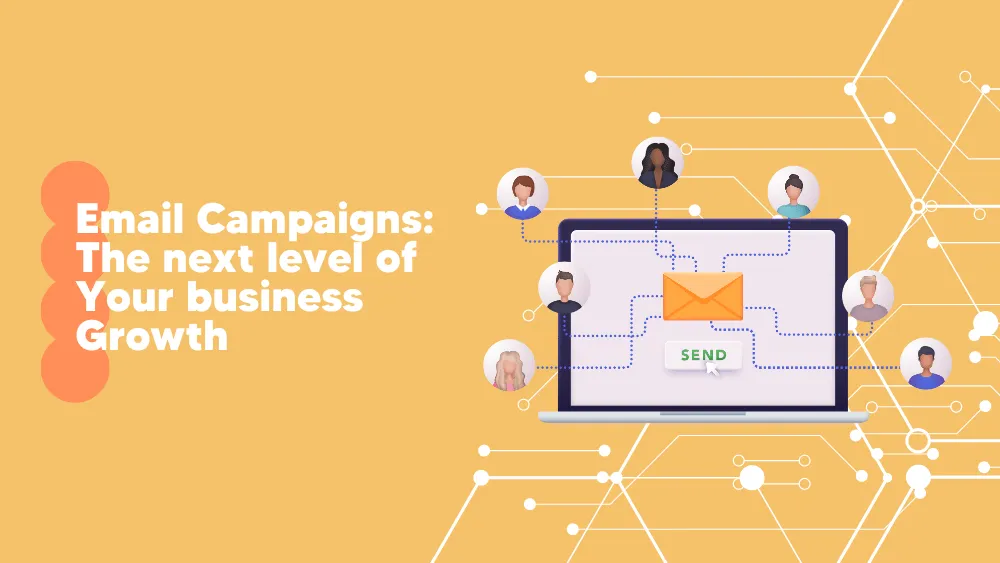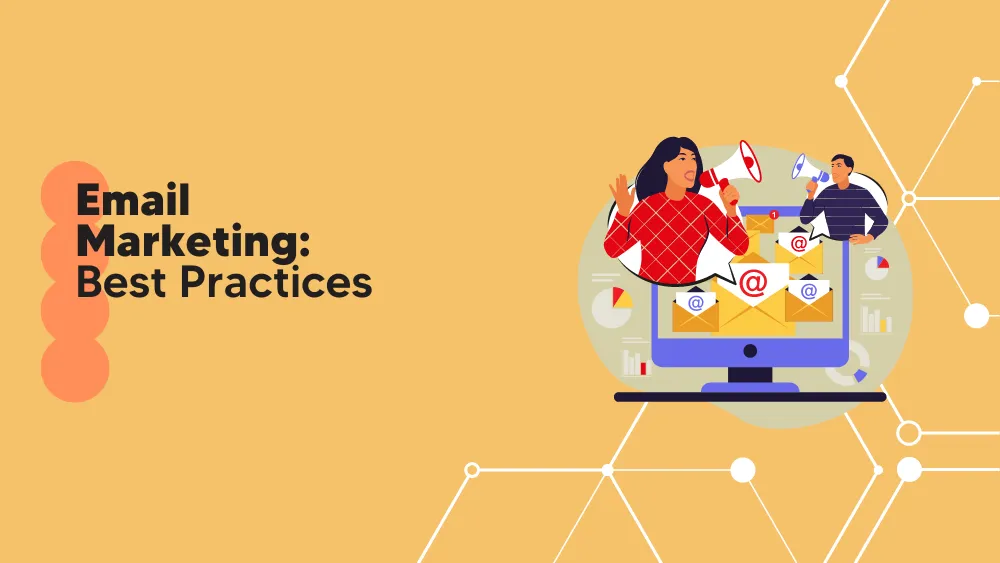Table of Contents
In a society like this, where communication channels seem endless, one method has stood the test of time and remains a potent tool for businesses: the email newsletter. This form of email marketing has proven worth offering a unique and powerful way to engage with customers, build brand loyalty, and drive business growth.
Email newsletters have emerged as a staple in the marketing arsenal of successful businesses across various industries. They provide direct communication between companies and their customers, enabling personalized interactions and fostering meaningful connections.
Unlike social media platforms or search engine algorithms, where your content may get lost in the noise, an email newsletter ensures that your message lands directly in your audience’s inbox, where they are more likely to engage with it.
This article aims to equip businesses with the necessary understanding and practical tools to leverage email newsletters’ power effectively. Whether new to the concept or looking to enhance your existing strategy, we will explore proven tactics and share valuable insights to help you achieve your marketing goals.
What is an Email Newsletter
To get a precise definition, an email newsletter is a digital communication sent to a targeted list of subscribers who have voluntarily opted in to receive updates, news, promotions, or other relevant content from a business or organization.
It is a regular publication that aims to provide valuable information, establish a connection with the audience, and promote engagement.
Unlike promotional emails or transactional messages, email newsletters typically encompass a broader range of content. They often include a mix of educational articles, industry news, product updates, upcoming events, special offers, and other valuable resources tailored to the interests and needs of the subscribers.
Direct and Personalized Communication
Email newsletters provide a direct line of communication between businesses and their subscribers. Unlike social media platforms, where algorithms determine which content users see, newsletters land directly in the intended recipient’s inbox.
This allows for more personalized and intimate interaction, enhancing the chances of engagement, fostering a sense of exclusivity, and building a solid customer base.
Building and Nurturing Relationships
Email newsletters allow businesses to build strong and meaningful relationships with their audience. By consistently providing valuable content, businesses can establish trust, credibility, and expertise, positioning themselves as a go-to resource for their subscribers. Over time, this relationship-building approach can lead to increased brand loyalty, customer retention, and advocacy.
Targeted and Segmented Messaging
With email newsletters, businesses can segment their subscriber list based on demographics, interests, or past behaviors. This segmentation enables the creation of targeted and personalized content that resonates with specific groups of subscribers.
Businesses can deliver more relevant and compelling content by tailoring the message to address their unique needs and preferences, leading to higher open rates, click-through rates, and conversions.
Cost-Effective Marketing
Email newsletters offer an incredibly cost-effective marketing solution. Compared to traditional marketing channels like print media or direct mail, email newsletters are significantly more affordable, often requiring minimal design, distribution, and analytics expenses.
Moreover, with automation tools available, businesses can streamline the process, saving time and resources while reaching a large audience in a targeted and efficient manner.
Measurable Results and Data Insights
Email newsletters provide businesses with a wealth of data and insights to measure the success of their campaigns. Through email marketing platforms, businesses can track open rates, click-through rates, conversion rates, and subscriber engagement.
These analytics enable businesses to gauge the effectiveness of their content, understand subscriber preferences, and make data-driven decisions to optimize future campaigns.
Increased Website Traffic and Conversions
Well-crafted email newsletters can drive significant traffic to a business’s website. By including relevant links, compelling calls-to-action, and enticing offers, newsletters can direct subscribers to specific landing pages or product pages, increasing the chances of conversions.
Additionally, email newsletters can catalyze social sharing, allowing subscribers to easily share valuable content with their networks, further expanding the reach of the business’s message.
In summary, email newsletters are a powerful marketing tool that enables businesses to establish direct communication with their audience, build relationships, and provide valuable content.
By leveraging the unique advantages of email newsletters, businesses can nurture customer loyalty, increase brand visibility, and drive conversions, ultimately contributing to their overall growth and success.
Benefits of Email Newsletter
Email newsletters have become an integral part of marketing strategies for businesses of all sizes. They offer numerous benefits, including increased customer engagement, brand awareness, and lead generation.
It’s time to review these advantages and explore some statistics and case studies that highlight the effectiveness of email newsletters in driving business growth.
-
Increased Customer Engagement
Email newsletters provide direct communication with your audience, allowing you to engage with them regularly. You can establish a stronger connection and build trust by delivering valuable content directly to their inboxes. According to a study by Campaign Monitor, email newsletters have an average open rate of 17.92% and a click-through rate of 14.10%, indicating that subscribers actively engage with the content they receive.
Case Study:
-
Brand Awareness
Email newsletters offer a platform to showcase your brand and keep it at the forefront of your subscribers’ minds. You reinforce brand recognition and create a lasting impression by consistently delivering branded content and updates. A survey by Radicati Group found that the number of worldwide email users is projected to reach 4.6 billion by 2025, indicating the vast potential for brand exposure through email newsletters.
Case Study:
-
Lead Generation
Email newsletters are a powerful tool for generating leads and nurturing potential customers. By strategically including call-to-action buttons, relevant offers, or gated content within your newsletters, you can drive traffic to your website and capture valuable leads. According to a study by McKinsey & Company, email is nearly 40 times more effective at acquiring customers than Facebook and Twitter combined.
Case Study:
As we can see, email newsletters provide several benefits for businesses seeking to drive growth. They enable increased customer engagement, allowing you to connect with your audience on a very personal level. Furthermore, they enhance brand awareness by consistently delivering branded content, reinforcing recognition and exposure.
Finally, they serve as effective lead-generation tools, helping you capture valuable leads and convert them into paying customers. Supported by statistics and case studies, it’s evident that email newsletters are a valuable asset in any marketing arsenal, offering tangible results and driving business growth.
Key Elements of an Effective Email Newsletter
Let’s be clear: an effective email newsletter is more than just a random assortment of content sent to subscribers. It requires careful planning and attention to key elements contributing to its success.
Let’s analyze the essential components that make up a successful email newsletter.-
Compelling Subject Lines
The subject line is the first thing subscribers see in their inboxes, so it needs to grab their attention and entice them to open the email. A compelling subject line should be concise, intriguing, and relevant to the content inside. You can increase open rates and engagement by using persuasive language, posing a question, or creating a sense of urgency.
Example: “Unlock the Secrets to Boosting Your Productivity Today!”-
Engaging Content
Your newsletter’s content should be valuable, informative, and relevant to your target audience. Understanding your customers’ pain points and providing solutions or insights that address their needs is essential. Consider including a mix of articles, blog posts, videos, infographics, or other types of content that resonate with your subscribers. Engaging content keeps readers interested and encourages them to continue opening your emails.
-
Personalization and Segmentation
As said, personalization is crucial for creating a tailored experience that resonates with individual subscribers. By segmenting your email list based on demographics, preferences, or past interactions, you can deliver relevant content to specific groups. Personalized emails have been shown to generate higher open rates, click-through rates, and conversion rates, as they make subscribers feel valued and understood.
-
Clear Call-to-Action (CTA) Buttons
A call-to-action button is a direct invitation for readers to take a specific action, such as purchasing, signing up for a webinar, or downloading a resource. Making your CTAs clear, visually appealing, and easy to click is crucial. Use action-oriented language and place the CTA strategically within the email to guide readers toward the desired action.
-
Mobile Optimization
Last but not least: optimizing your email newsletter for mobile devices is essential with the increasing use of smartphones and tablets. Ensure your newsletter design is responsive and adapts well to different screen sizes. Use a mobile-friendly layout, legible fonts, and appropriately sized images to enhance the reading experience on mobile devices. Mobile optimization improves accessibility and ensures that your newsletter reaches a wider audience.
By incorporating these key elements into your email newsletter, you can create a compelling communication tool that engages your subscribers, delivers value, and drives desired actions. Remember to continually test and analyze the performance of your newsletters, making adjustments based on subscriber feedback and engagement metrics to optimize your results.
Email Newsletter Tools to Enhance Strategy
How to optimize email newsletter strategies in practical terms? To do so, businesses can leverage various powerful tools that offer unique features and benefits.
Here are five tools that can enhance your email newsletter strategy:
-
MailChimp
MailChimp is an all-in-one marketing platform trusted by millions of businesses. It offers a comprehensive set of features to support email marketing campaigns, including:
- Easy-to-use drag-and-drop editor for creating visually appealing newsletters.
- Automation workflows to send personalized emails based on customer behavior.
- Advanced segmentation options to target specific groups with tailored content.
- Analytics and reporting to measure campaign performance and make data-driven decisions.
- Integration with various third-party tools, such as CRMs and e-commerce platforms.
-
Brevo (formerly Sendinblue)
Brevo is an all-in-one marketing and CRM stack that provides scalable solutions for businesses of all sizes. Key features include:
- Intuitive drag-and-drop editor and customizable templates for designing engaging newsletters.
- Marketing automation to streamline communication and nurture leads through personalized journeys.
- CRM capabilities to manage and segment contacts effectively.
- Transactional email functionality for timely and relevant communication.
- SMS marketing capabilities for multi-channel communication with customers.
-
Constant Contact
Constant Contact is a popular email marketing tool known for its user-friendly interface and wide range of features, like:
- Customizable templates and a drag-and-drop editor for creating professional-looking newsletters.
- List management and segmentation to target specific audiences.
- Automation features to send triggered emails based on customer actions.
- Real-time tracking and reporting to measure the success of campaigns.
- Integration with other marketing tools, such as social media platforms and e-commerce systems.
-
ConvertKit
ConvertKit is an email marketing tool for creators, bloggers, and small businesses. Its key features are:
- Easy-to-use visual automation builder for creating email sequences.
- Customizable forms and landing pages to capture leads.
- Tag-based subscriber management to segment and target specific audiences.
- Personalization options for delivering tailored content to subscribers.
- Integration with popular tools like WordPress, Shopify, and Teachable.
-
AWeber
AWeber is an email marketing platform that offers a range of features to help businesses create and automate their newsletters, such as:
- Drag-and-drop email builder with customizable templates for creating professional newsletters.
- Automation features for sending targeted and personalized email sequences.
- Subscriber management and segmentation options for organizing contact lists.
- Robust analytics and reporting to track the performance of campaigns.
- Integration with various third-party tools, such as WordPress and Shopify.
These tools give businesses the necessary features to optimize email newsletter strategies. Each tool offers unique capabilities that cater to different business needs and objectives.
By selecting the tool that aligns best with your requirements, you can streamline your newsletter creation process, automate campaigns, segment your audience, and measure the effectiveness of your email marketing efforts.
Measuring Success and Iterating
Measuring the success of email newsletters, of course, is paramount for assessing their effectiveness and making data-driven decisions to improve strategies. Businesses can gain valuable insights into subscriber engagement and optimize their email campaigns by tracking relevant metrics.
Here’s the importance of measuring success, monitoring key metrics, and how businesses can iterate and improve their email newsletters.
Importance of Tracking and Measuring
Tracking and measuring key metrics allow businesses to evaluate their email newsletters’ performance objectively. It provides insights into subscriber behavior, content effectiveness, and overall campaign success. By understanding what works and what doesn’t, businesses can refine their strategies, increase engagement, and drive better results.
Relevant Metrics to Monitor
- Open Rates:The percentage of recipients who open your emails. It indicates the effectiveness of subject lines and overall email relevance.
- Click-through Rates (CTRs): The percentage of recipients who click on links within your emails. It measures the effectiveness of your content and calls to action.
- Conversion Rates: The percentage of recipients who complete a desired action, such as purchasing or filling out a form. It assesses the effectiveness of your email in driving desired outcomes.
- Unsubscribe Rates: The percentage of recipients who opt out of your email list. It indicates the overall subscriber satisfaction and relevance of your content.
Analyzing Data and Making Data-Driven Decisions
- Identify Trends: Analyze data over time to identify trends and patterns in engagement metrics. To optimize email delivery schedules, look for recurring patterns, such as higher engagement on specific days or times.
- Segment Analysis: Analyze metrics based on audience segments to identify preferences and tailor content accordingly. Identify segments with higher engagement or conversion rates and replicate successful strategies.
- A/B Testing: Conduct A/B tests on various elements of your email newsletters, such as subject lines, content, or calls to action. Compare metrics to identify the most effective strategies and refine your approach.
- Feedback Analysis: Pay attention to subscriber feedback, such as replies or survey responses. Use this qualitative data to gain insights into subscriber preferences, pain points, and suggestions for improvement.
Iteration, Testing, and Optimization
- Continuous Improvement: Use the insights gained from data analysis to iterate and optimize your email newsletters. Implement changes based on performance metrics and subscriber feedback to enhance engagement and conversions.
- Test New Strategies: Experiment with different approaches, such as personalization, segmentation, or content variations, to discover what resonates best with your audience.
- Monitor Performance: Regularly track and monitor metrics to assess the impact of optimizations and adjustments. Keep iterating based on performance trends and subscriber feedback.
Businesses can continuously improve their email newsletter strategies by consistently tracking and measuring key metrics, analyzing data, and making data-driven decisions. It’s important to iterate, test new ideas, and optimize based on insights gained from performance metrics.
With a focus on continuous improvement, businesses can enhance subscriber engagement, drive conversions, and achieve better results from their email newsletters.
Conclusion
Based on what we have just reviewed, email newsletters are a powerful tool for businesses seeking growth and success in the digital landscape.
Throughout this complete guide, we explored the benefits of email newsletters, key elements of an effective strategy, and powerful tools available to optimize their implementation.
Email newsletters offer several advantages, including increased customer engagement, brand awareness, and lead generation. Businesses can establish stronger connections, build trust, and drive customer loyalty by delivering valuable content directly to subscribers’ inboxes.
To ensure the success of email newsletters, businesses must prioritize specific elements. These elements include developing attention-grabbing subject lines, creating engaging content, personalizing messages, including clear calls-to-action, and optimizing for mobile devices.
Understanding the immense potential of email newsletters and the opportunities they present for achieving business objectives is crucial. By implementing these strategies, businesses can harness the power of these tools and transform their email newsletters into a catalyst for growth and success.







